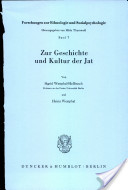Zur geschichte und Kultur der Jat/Review

Zur Geschichte und Kullur der Jut.
Sigrid Westphal-Hellbusch und Heinz Westphal.
Forschungen zur Ethnologie und Sozialpsychologie, Band 7. Berlin: Duncker Xr Humblot, 1968. 367 pp., bibliography , figures, illustrations, indexes, maps, tables, genealogical tables
Reviewed by Albert Heinrich The University of Calgary
The Jats are an ethnic group whose origin we may never know. Jats were already known in Roman times in the Near and Middle East, presumably having spread out of Sind as seafarers and traders. Jats were also found as buffalo herders on the Euphrates in pre-Islamic times. They were also known, from Aleppo to India, as militaristic, often mercenary, pastoralists.
The Persians used the term “Jat” to designate certain components of their polyglot armies.
The Arabs used the term, as well as “Zutt,” to designate all people who came from the land of Sind, but they also tended to confuse the meaning with that of “gypsy.”
The Pathan and Baluch used the term to designate semi-subject peoples who lived in their midst.
Today, people termed “Jats” are found in northwest India and Pakistan as herdsmen of various sorts, and sometimes as farmers, divided into various segmentary groups. The history that lies between is what the authors have tried to clarify. They have done a good job of research, often apparently with recondite and relatively retractable data, but a certain amount of uncertainty still beclouds the scene.
It has been the fate, or fortune, of the Jats never to have set up a state, though various Jat groups have been political powers from time to time.
Their history, and perhaps one can say their origin in a sociological sense, has been one of adjustment to three factors.
- Firstly, they were part and parcel of the general migrations from the highland areas into the Indus watershed.
- Secondly, the Jats were intimately caught up in the Islamic movement.
- Finally, they have for a long time been, and still are, buffeted about by the push and pull of forces extraneous to them.
Many of them are now devout Moslems and proclaim a certain “Peer” as their patron; some claim that their ruling house is descended from someone close to the Prophet, and/or claim to have come “from Aleppo.” But some have oral histories telling of their conversion to Islam, and, their present culture, though it partakes of a
very heavy overlay of Islamic features, is still marked, say the authors, by many non- Islamic features.
The Jats with whom this book is concerned have, both outside and in the Indian subcontinent, been primarily herdsmen who sometimes turned to a bit of farming, and who often willingly or by force of circumstances served as mercenaries. They appear to have had a special attachment to the water buffalo, but, depending on the environment and the market, they have been quite willing to change their basic subsistence patterns.
They have been, and are, extremely flexible. The Jats were often caught in a squeeze between various Islamic disputes, as well as between opposing political forces. Here, too, they adapted. The adaptation often took the form of military service, very often with Jats on opposing sides.
Throughout their history they have had the reputation of being extremely loyal. Once having given their pledge, they remained true to it, even fighting other Jats if the need arose.
One sometimes wonders whether Jats really exist as an ethnic entity to the degree the authors claim, or whether the essence of Jatness lies more in the conception of outsiders, in the term “Jat” being an all-inclusive Sammelbegriff, a catch- all designation. The authors conclude by stating that, despite some misuse of the term “Jat” as a catchall category, if a group is called “Jat” and has a Stammesorganisation, they are Jats. This Stammesorganisation is a clan-like organization that encompasses common territory, common speech, common culture, common name, and usually a real or putative common ancestor. In closing, several criticisms are in order. The title is somewhat misleading.
One is led to believe that it is culture history arid ethnography of the Jat. But, though it begins with the Jat, as it progresses to the present, it narrows down to the Jat of Sind and Kutch. Only passing references are made to other Jats, such as those of the Punjab, either with regard to the present or historically. There also seems to be an overemphasis of tie-up between Islam and Jat, especially after several references (unsupported by documentation) to the present Indian government’s suspicion of Jats because of their religion.
There is also a certain “wandering” in the text-too much detailing of ancillary material. Allied to this is too much reference to fragments of oral literature, and too much reference to conjectural (verm u tlich) evidence. Kutch is consistently referred to unequivocally as an island. Though it is a cultural island in a sense, and is geographically almost an island part of the year, this usage of the term Znsel seems inappropriate. The authors go to some length to explain to the reader that the English term “cattle” is not to be confused with German Kuh. German Viehzeug would seem to be a perfectly good translation.
The language of the book, and the style generally, are neither complicated nor artificial. The illustrations are helpful, and the indexes and appendices are very well done and helpful. The maps could be better. The price-D.M. 78-is prohibitive.
External links
Back to Jat History

